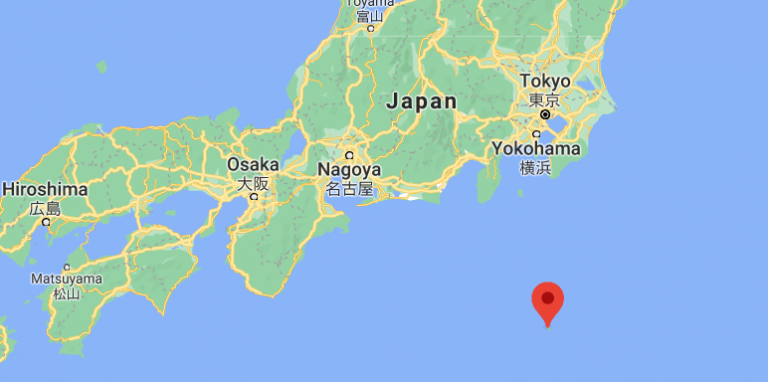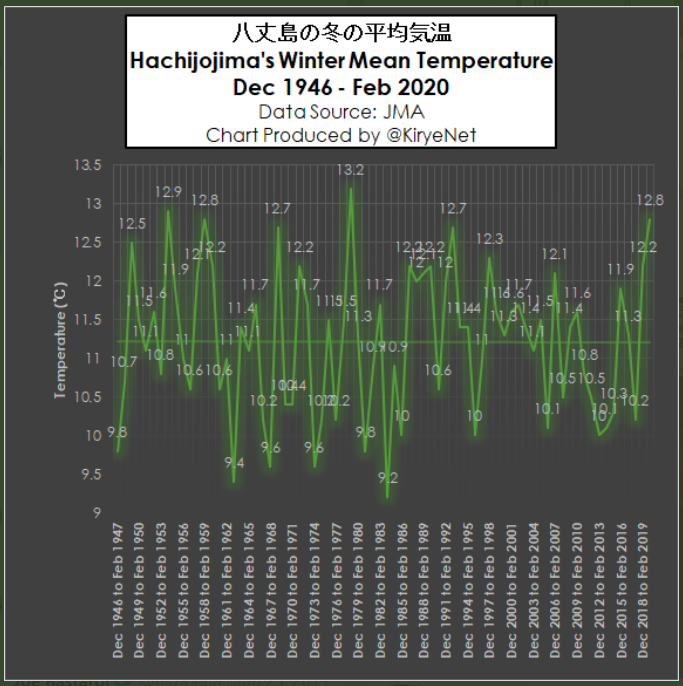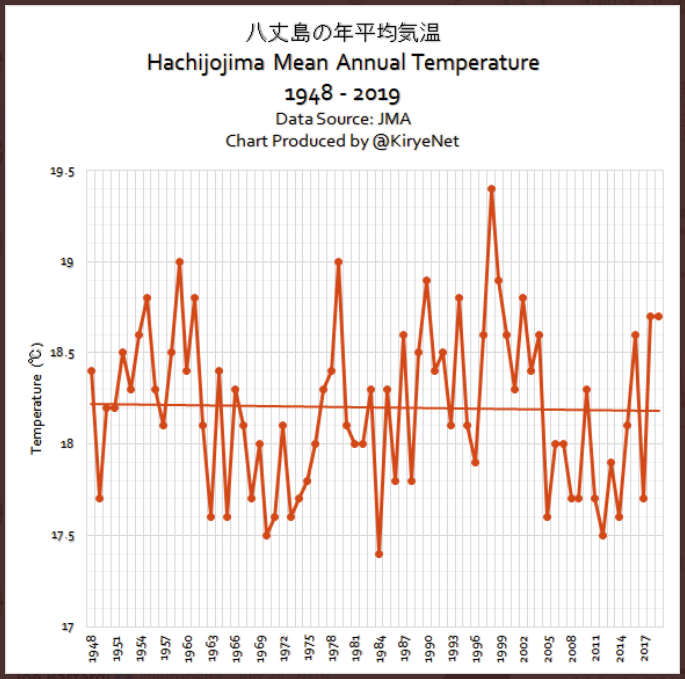By Kirye
and Pierre Gosselin
Hachijojima is a volcanic Japanese island some 287 kilometers south of Tokyo, to which it belongs. 7,522 people live on its 63 km2 of area.
Image cropped from Google Maps.
What makes Hachijojima interesting climatically is its rural, non-urban features – in the middle of the ocean – making station siting there less prone to factors that could corrupt the data, such as airports, asphalt, concrete, steel and other heat-sink-acting infrastructure.
Today we look at data from the Japan Meteorological Agency (JMA) going back almost 80 years. Hearing all the claims about a rapidly warming world from the media, many readers would think that there must be warming happening there as well. The data have a surprise in store.
Summer
Now that summer has ended, we plot the latest data to see if summers have indeed been warming at this island.
Data source: JMA
As the above data show, there has been virtually no trend at all over the past 80 years. Warming? Still no sign of it at all.
Winter
Next we look at the mean winter temperatures at this location since 1947:
Data source: JMA
Like summer, also winter has shown no long-term trend one way or the other. Where’s the bad climate change news here?
Annual
To round out the analysis and to summarize, we plot the annual mean temperature data recorded for Hachjojima:
Data source: JMA
Interestingly, the annual temperature behavior appears to follow a cyclic behavior that very much resemble some ocean surface temperature cycles we see from around the globe, like the PDO or AMO. Climate indeed changes, but what we see above it cannot be due to anything anthropogenic.









[…] Read more at No Tricks Zone […]
And this is GISS NASA’s take on Hachijojama.
https://data.giss.nasa.gov/cgi-bin/gistemp/stdata_show_v4.cgi?id=JA000047678&ds=14&dt=1
Note the ‘raw’ data (light yellow in the background).
Original temp data base before too many adjustments.
https://data.giss.nasa.gov/cgi-bin/gistemp/show_station.cgi?id=210476780002&dt=1&ds=1
I wonder where GISS got the data for the years 1908 to 1947?
Or did the post here not show the data for that period?
It is a serious question that needs answering.
It’s called infilling
http://berkeleyearth.org/understanding-adjustments-temperature-data-new/
mwhite
The Australian BoM has recently adjusted all of Aust’s annual mean temps from at least 1995 to 2017 by upwards of +0.1C. As these adjustments have been mainly made to Automatic Weather Sites (i.e. thermometers) it negates all the reasons outlined in the article as to why adjustments are necessary.
More B.S.-ing, IMO.
https://calderup.wordpress.com/2011/10/22/hoodwinked-by-berkeley-earth/
The airport and most of the population is under 100 m. elevation and in a swath 5 km. Wide. This situation likely clears out any heat island effect that, elsewhere, seems to raise the nighttime temperature.
As a contrary argument to global warming this may be the useful “one.”
Why 100? If I were wrong, one would have been enough. [In response to “Hundred Authors Against Einstein”]
swath 5 km. Wide. {Software wants that ‘w’ to be CAP.}
Sorry/ That was meant to be 5 km from one beach to the other (ocean to ocean); so length, not, width through the valley.
[…] Read more at No Tricks Zone […]
On its UHI page Wikipedia shows a comparison from the Japan Meteorological Agency of stations including Tokyo, Yokohama and Katsuura a town on the Pacific coast about 80 KM from the centre of Tokyo that shows no net warming 1917- 2007.
https://en.wikipedia.org/wiki/Urban_heat_island
Meanwhile GISS has turned no net warming into ~+1.5C over the same period.
https://data.giss.nasa.gov/cgi-bin/gistemp/stdata_show_v4.cgi?id=JA000047674&ds=14&dt=1
What is apparent in those graphs is the peak in 1997/8.
This matches the original NOAA data that showed 1997/8 much warmer than todays temperatures, including the 2016 El Nino, before they lowered the 1997 data.
A similar situation applies to the long term high quality weather station at Willis Island in the Coral Sea. See:https://quadrant.org.au/opinion/doomed-planet/2020/04/the-reef-could-use-a-dose-of-the-wuhan-flu/
[…] Hachijojima, Isolated Rural Island In Pacific, Shows No Warming In 80 Years […]